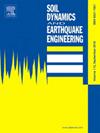Performance of Reyhanlı Dam during February 6, 2023 Kahramanmaraş-Türkiye earthquake sequence
IF 4.2
2区 工程技术
Q1 ENGINEERING, GEOLOGICAL
引用次数: 0
Abstract
The February 6, 2023 Türkiye-Kahramanmaraş earthquake sequence subjected Reyhanlı Dam to strong near-source ground motions. The dam is located in Hatay-Reyhanlı district of Türkiye, 23.2 km away from the fault rupture plane of the Kahramanmaraş-Pazarcık M7.8 event. The peak ground acceleration at comparable distances from the fault ruptures was estimated to vary in the range 0.1–0.4 g and 0.02–0.04 g, during Pazarcık and Ekinözü-Elbistan events. Consistently the peak ground rock acceleration at the dam site is governed by Pazarcık event, and estimated as 0.3 g. The permanent total ground deformations, in terms of lateral and vertical displacements were mapped at the crest and reported to vary in the range of 10–30 cm, and 100–120 cm, respectively. No surface manifestation of soil liquefaction was observed at the dam body, or at its foundation soils. As part of preliminary reconnaissance assessments, limit equilibrium-based slope stability and simplified permanent deformation assessments were performed to evaluate the conformity of the predicted and observed responses. In between KM: 0+900 to 2+000 the permanent displacements consistently increase with increasing the transverse section height of the dam. Bray and Travasarou (2007) [20] semi-empirical simplified method produced the most consistent predictions for both the upstream and downstream slopes. In between KM: 6+000–8+120, large displacements were observed, higher than the values predicted by all methods, but in better conformance with the ones of Makdisi and Seed (1979) [15]. The increased permanent displacements were attributed to the presence of sand lenses in the foundation, which might have been cyclically softened, or even cyclically liquefied during the Pazarcık event.
2023年2月6日kahramanmara - trkiye地震序列期间reyhanlyi大坝的表现
2023年2月6日发生的 rkiye- kahramanmaraki地震序列使reyhanlyi大坝遭受强烈的近源地面运动。该大坝位于t rkiye的hatay - reyhanlyi地区,距离Kahramanmaraş-Pazarcık 7.8级地震的断层破裂面23.2公里。在Pazarcık和Ekinözü-Elbistan事件期间,距离断层破裂相当距离处的峰值地面加速度估计在0.1-0.4 g和0.02-0.04 g范围内变化。坝址地面岩石加速度峰值始终受Pazarcık事件控制,估计为0.3 g。根据横向和垂直位移,在波峰处绘制了永久总地面变形,并分别在10-30厘米和100-120厘米范围内变化。坝体及坝基土均未见地表土壤液化现象。作为初步勘察评估的一部分,进行了基于极限平衡的边坡稳定性和简化的永久变形评估,以评估预测和观测响应的一致性。在KM: 0+900至2+000之间,永久位移随坝体横断面高度的增加而持续增加。Bray和Travasarou(2007)[20]半经验简化方法对上游和下游斜坡都产生了最一致的预测。在KM: 6+ 000-8 +120之间,观测到较大的位移,高于所有方法的预测值,但与Makdisi和Seed(1979)[15]的预测值更吻合。增加的永久位移归因于地基中存在的砂透镜,这些砂透镜可能在Pazarcık事件期间被周期性软化,甚至周期性液化。
本文章由计算机程序翻译,如有差异,请以英文原文为准。
求助全文
约1分钟内获得全文
求助全文
来源期刊

Soil Dynamics and Earthquake Engineering
工程技术-地球科学综合
CiteScore
7.50
自引率
15.00%
发文量
446
审稿时长
8 months
期刊介绍:
The journal aims to encourage and enhance the role of mechanics and other disciplines as they relate to earthquake engineering by providing opportunities for the publication of the work of applied mathematicians, engineers and other applied scientists involved in solving problems closely related to the field of earthquake engineering and geotechnical earthquake engineering.
Emphasis is placed on new concepts and techniques, but case histories will also be published if they enhance the presentation and understanding of new technical concepts.
 求助内容:
求助内容: 应助结果提醒方式:
应助结果提醒方式:


